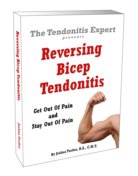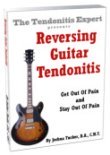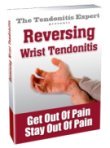Tendonitis of the Arm
First off, let's clear up the term Tendonitis of the Arm.
There is no such thing as Arm Tendonitis. You can certainly have some Tendonitis on one or more areas of your arm, but you don't have Tendonitis of the entire arm.
So if your doctor told you you have Arm Tendonitis, we need to look a little closer.
If you have pain in your wrist and/or forearm, you possibly have Wrist Tendonitis or Tennis Elbow (or Golfer's Elbow).
If you have pain in your inner elbow and/or biceps area, then you likely have Biceps Tendonitis.
If you have pain up higher in your shoulder, then you likely have some kind of Shoulder Tendonitis.
Tendonitis of the Arm
Specific Locations of Tendonitis
If you think that you have Tendonitis of the Arm, let's get more specific.
It is true that everything is connected, and everything works together. And, it would be great to treat your ENTIRE arm structure.
Still, you may need to focus on one are specifically.
So. If you have.....
Wrist Tendonitis
Wrist Tendonitis is pain in the wrist area.
The problem can be at or near the wrist itself, and/or down into the hand and up into the forearm.
Forearm muscles and connective tissue structures are a main cause of wrist problem.
It is also important to differentiate between Wrist Tendonitis and Carpal Tunnel Syndrome
Find out more about Wrist Tendonitis
Tennis Elbow (and Golfer's Elbow)
Tennis Elbow is a Tendonitis dynamic on the back-of-the-hand side of the forearms at/near the elbow.
Golfer's Elbow is the same thing, but on the opposite side of the forearm.
A tendinitis dynamic in the forearm can cause pain, weakness, and limitation in use of the hand, and use of the entire arm.
You can get Tennis Elbow from sports activity, or working the computer, or from a hobby knitting.
Find out more in-depth information on Tennis Elbow
Bicep Tendonitis
People with Bicep Tendonitis usually complain of pain when straightening their arm, and/or when bending their arm.
They also complain that they -can't- straighten their arm out.
Biceps Tendonitis occurs when the biceps muscles are too tight and short, the connective tissue is too tight/short, and then suddenly the body can't compensate for it and you have pain.
Essentially, you hurt because your body is trying to stop you from what it thinks is 'pulling your structures apart'
To find out more about this type of Tendonitis of the Arm, go to the Bicep Tendonitis page.
Triceps Tendonitis
I don't have a page built yet for Triceps Tendonitis, but it's essentially the same as Bicep Tendonitis.
Shoulder Tendonitis
Shoulder Tendonitis means that one or more of the tendons of the shoulder cuff (and the muscles/connective tissue attached to the tendons, of course) are irritated and inflammed.
This can get a bit tricky because there's a lot of real estate to cover, and many different moving parts.
Muscle imbalance can actually cause pain, as one part is overworked and some other(s) are 'weak'.
Or one or more of the tendons can get irritated from Repetitive Use.
For more indepth on this type of Tendonitis of the Arm, see the Shoulder Tendonitis page.
Whiplash and Neck Tendonitis
How can a neck problem be part of Tendonitis of the Arm?
Easy.
Neck muscles and connective tissue structures attach to structures at the top of the shoulder, including clavicle, top two ribs, and shoulder muscle connective tissue structures.
A problem in the neck can cause arm pain, and can cause the body to tighten up arm muscles which can cause, lead to, or mimic pain in the arm.
To find out more indepth information about this aspect of Tendonitis of the Arm, see the Whiplash page.
Return to the top of this
Tendonitis of the Arm page.
Go to the main
Tendonitis page.
Go to the
TendonitisExpert.com homepage.
Enjoy this page? Please pay it forward. Here's how...
Would you prefer to share this page with others by linking to it?
- Click on the HTML link code below.
- Copy and paste it, adding a note of your own, into your blog, a Web page, forums, a blog comment,
your Facebook account, or anywhere that someone would find this page valuable.
|






